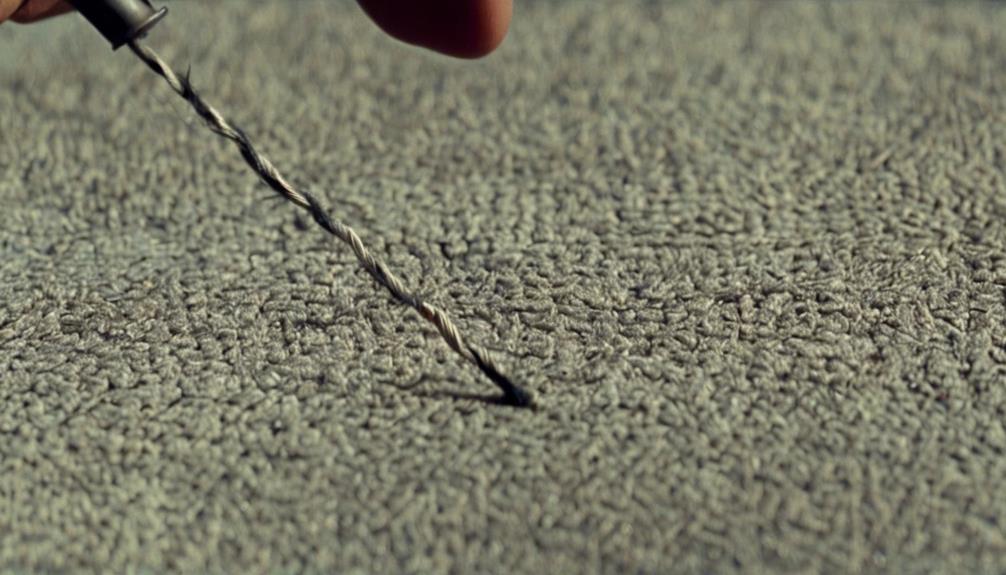Did you know that a poorly tied fishing knot is the number one reason for lost fish?
Whether you're an experienced angler or just starting out, ensuring your knots are strong and reliable is crucial for a successful day on the water.
With so many different knot-tying techniques out there, it can be challenging to know which ones will hold up under pressure.
But fear not, because in this article, we'll explore four of the best techniques to test fishing knots.
By the end, you'll have the knowledge and confidence to trust your knots and reel in that prized catch.
Visual Inspection
When checking fishing knots, visually inspect for any signs of fraying or damage to ensure their strength and reliability. Knot tightness is crucial in ensuring that the knot will hold when under pressure. After tying the knot, give it a firm tug to make sure it holds. If the knot slips or loosens, it needs to be retied. Additionally, inspect the material compatibility of the knot. Make sure that the knot is appropriate for the type of fishing line being used. Different types of line may require different knots for optimal performance.
To visually inspect the knot, hold the hook or lure in one hand and the main line in the other. Examine the knot closely to ensure that it's tight and without any visible signs of wear. Look for any fraying or damage to the knot or the line itself. Feel the knot between your fingers to check for any inconsistencies or rough spots. This tactile inspection can reveal any imperfections that may not be immediately visible.
Material compatibility is also essential. Different fishing lines have different properties, such as stretch and strength, and it's important to choose a knot that complements these characteristics. Some knots may work well with monofilament lines but may not be suitable for braided lines. Understanding the material compatibility of the knot and the fishing line will help ensure that the knot holds up when it matters most.
Tug Test
Inspect the knot's integrity by giving it a firm tug to ensure it can withstand pressure and hold securely in place. The tug test is a crucial step in evaluating the tightness and strength of your fishing knot. When performing the tug test, apply steady pressure to the line and observe how the knot reacts. A well-tied knot should hold firm without slipping or breaking under this tension. This evaluation will help you determine whether the knot is secure enough to withstand the force of a fighting fish.
When comparing tug tests between different knots, pay close attention to how each knot responds to the applied pressure. Some knots may show signs of slippage or instability when subjected to a tug test, indicating that they may not be the best choice for securing your fishing line. By conducting a tug test comparison, you can identify which knots perform best under pressure and select the most reliable option for your fishing needs.
During the knot tightness evaluation, it's essential to look for any signs of weakness or failure. If the knot slips or loosens during the tug test, it may not be secure enough to trust during a fishing excursion. By carefully assessing the knot's response to the tug test, you can ensure that your fishing knots are reliable and capable of withstanding the challenges of angling.
Stress Test
Perform a stress test on the fishing knot to assess its ability to withstand pressure and maintain its integrity. Start by attaching one end of the line to a secure anchor point and the other end to a scale. Slowly apply pressure to the line by pulling on the scale. Monitor the knot closely for any signs of slipping, tightening, or deformation. The goal is to determine the maximum amount of force the knot can handle before failing. This stress test is crucial for evaluating the knot's reliability in real-life fishing situations.
When conducting the stress test, pay attention to the behavior of the knot under increasing tension. A strong and reliable knot should maintain its structure and hold firm even as the pressure mounts. If the knot starts to slip or show signs of weakness, it indicates potential failure when faced with the resistance of a fighting fish. By subjecting the knot to a stress test, you can gain valuable insights into its performance and make informed decisions about its suitability for different fishing scenarios.
Ultimately, the stress test provides essential data about the knot's ability to withstand the forces encountered during fishing, such as the sudden bursts of energy from a hooked fish. This information empowers you to select the most dependable knots for your fishing endeavors, ensuring a higher likelihood of landing your prized catch without the fear of knot failure.
Knot Strength Test
To assess the strength of a fishing knot, apply gradual tension to the line while closely observing for any signs of weakening or deformation. When conducting a knot strength test, it's crucial to employ proper knot tying techniques to ensure that the knot is tied correctly and to the manufacturer's specifications. This involves carefully following the recommended steps for the specific knot being tested, as even a small mistake in tying the knot can significantly affect its strength.
In addition to proper knot tying techniques, it's essential to consider the materials used for the knot. Different types of fishing lines and leaders have varying tensile strengths and properties, which can influence the overall strength of the knot. When comparing knot materials, it's important to take into account factors such as the diameter and composition of the line or leader. Thinner lines may require different knot-tying techniques compared to thicker lines, and certain materials may be more prone to slippage or abrasion, affecting the knot's overall strength.
When conducting knot strength tests, it's advisable to compare the performance of different knots using the same material and diameter. This allows for a more accurate assessment of the knot's strength and helps in determining which knot is best suited for the specific fishing application. By carefully considering knot tying techniques and material comparisons, anglers can ensure that their knots are strong and reliable, ultimately leading to more successful fishing experiences.
Wet Knot Test
When testing fishing knots, a crucial aspect to consider is the performance of the knot when wet, as this can significantly impact its strength and reliability in real fishing conditions.
When a fishing knot is submerged in water, its behavior can change due to water resistance and knot lubrication. Here's what you need to know about the wet knot test:
- Water Resistance: Testing a fishing knot's performance when wet is essential because water can weaken certain types of knots. For example, some knots may slip or become less secure when submerged, which compromises their reliability during actual fishing activities.
- Knot Lubrication: When wet, the lubrication between the knot's surfaces can change, affecting its overall tightness and strength. Understanding how a knot responds to changes in lubrication when wet is crucial for ensuring its reliability during fishing.
- Real Fishing Conditions: Conducting the wet knot test provides a realistic simulation of actual fishing scenarios. It allows anglers to assess how well a knot will hold up when exposed to water, helping them select the most reliable knots for their fishing needs.
Hook Set Test
Assess the hook's penetration and the knot's ability to withstand sudden tension by conducting a hook set test. This test is crucial for determining the strength and reliability of your fishing knot. To perform the hook set test, cast your line and then swiftly jerk or pull the rod to set the hook. This abrupt motion places a significant amount of stress on the knot and the hook's penetration into the target area. As you execute the hook set, observe how the knot holds up under the sudden tension and assess the hook's ability to penetrate and secure itself in the target.
When conducting the hook set test, pay attention to the knot's flexibility. A good fishing knot should allow the hook to penetrate easily into the fish's mouth or the surrounding area, ensuring a secure and reliable connection. If the knot is too stiff, it may inhibit the hook's ability to penetrate effectively, potentially resulting in missed catches or lost fish.
On the other hand, if the knot is too loose or lacks strength, it may fail to withstand the sudden tension of the hook set, leading to a lost fish.
Abrasion Test

You can gauge the knot's resistance to wear and tear by subjecting it to an abrasion test. This test simulates the friction and rubbing that a knot may experience when in contact with rough surfaces or sharp edges underwater.
To conduct an abrasion test, follow these steps:
- Select Abrasive Material: Begin by choosing an abrasive material that closely mimics the underwater conditions where the knot will be used. This could be sandpaper, rough rocks, or any other abrasive surface.
- Use Different Pressures: Apply varying pressures to the knot against the chosen abrasive material to test its abrasion resistance under different stresses.
- Monitor Material Durability: Observe the knot's material durability during the test. Note any signs of fraying, weakening, or damage to the knot's structure.
- Assess Knot Performance: Evaluate how the knot holds up to the abrasion test. Look for any changes in the knot's appearance, strength, or integrity after being subjected to the abrasive material.
Assessing a fishing knot's abrasion resistance through this test provides valuable insights into its ability to withstand rough underwater conditions. By examining the knot's material durability and performance under simulated abrasion, anglers can make informed decisions about the most suitable knots for their fishing needs.
Line Slippage Test
To test for line slippage, firmly secure one end of the fishing line to a fixed object, and apply consistent tension while assessing any potential movement or slipping along the knot. This test is crucial in determining the reliability of the knot, especially in situations where it's subjected to strong forces while fishing.
When conducting the line slippage test, it's essential to consider knot lubrication and friction analysis.
Knot lubrication plays a vital role in preventing line slippage. When tying your fishing knot, applying a small amount of saliva or water to the knot can reduce friction and heat generated during the tightening process. This simple step can significantly enhance the knot's strength and reduce the chances of line slippage under pressure. By incorporating knot lubrication into your knot-tying routine, you can minimize the risk of slippage, ultimately improving the overall performance of your fishing knot.
Moreover, conducting a friction analysis can provide valuable insights into the knot's ability to withstand pressure without slipping. By observing the knot under tension, you can assess any movement or slippage, allowing you to make necessary adjustments to enhance its security. Understanding the friction dynamics within the knot can help you choose the most suitable knot for different fishing scenarios, ensuring that it holds up when it matters most.
Frequently Asked Questions
What Are Some Common Mistakes People Make When Tying Fishing Knots?
When tying fishing knots, common mistakes include forgetting knot lubrication and applying improper tension.
Neglecting to lubricate the knot can lead to friction and weaken the knot's integrity.
Improper tension during knot tying can result in a loose and unreliable knot.
To ensure knot security, always remember to lubricate the knot and maintain proper tension throughout the tying process.
These simple steps can make a significant difference in the strength and reliability of your fishing knots.
How Can Different Types of Fishing Line Affect the Strength and Reliability of Knots?
When it comes to fishing line, the type you use can have a big impact on the strength and reliability of your knots. Different lines react differently to moisture and temperature, affecting knot strength.
To test knot reliability, try using different techniques such as pull testing and stress testing. These methods can help you determine how well your knots will hold up in different conditions, ultimately improving your fishing success.
Are There Any Specific Knots That Are Better for Certain Types of Fishing or Fishing Conditions?
When it comes to knot selection, it's essential to consider the fishing conditions you'll encounter.
Different fishing line types can affect the performance of knots, so choose the right knot for the specific conditions you'll be fishing in.
For example, certain knots may be better suited for heavy-duty lines in rough waters, while others may work best for lighter lines in calmer conditions.
Always match your knot tying technique to the fishing line types and conditions you're facing.
How Often Should Anglers Check and Re-Tie Their Fishing Knots?
Regular knot maintenance is crucial for anglers. Factors to consider when deciding when to retie knots include the type of fishing you're doing, the size and strength of your line, and any wear and tear on your gear.
It's important to check your fishing knots frequently, as worn or damaged knots can lead to lost catches. Be proactive and re-tie your knots whenever you notice any signs of weakness or damage.
Are There Any Tools or Devices That Can Help Anglers Test the Strength and Reliability of Their Knots?
When testing the strength and reliability of your knots, there are various knot testing tools available. These tools are designed to accurately measure the strength of your knots, giving you confidence in their reliability.
Conclusion
So there you have it, the 4 best techniques to test fishing knots.
By visually inspecting, tugging, stressing, and testing the strength of your knots, you can ensure they're secure and reliable for your next fishing trip.
Don't forget to also perform the wet knot, hook set, abrasion, and line slippage tests to cover all your bases.
With these techniques, you can have confidence in your knots and focus on reeling in the big catch.
Happy fishing!



